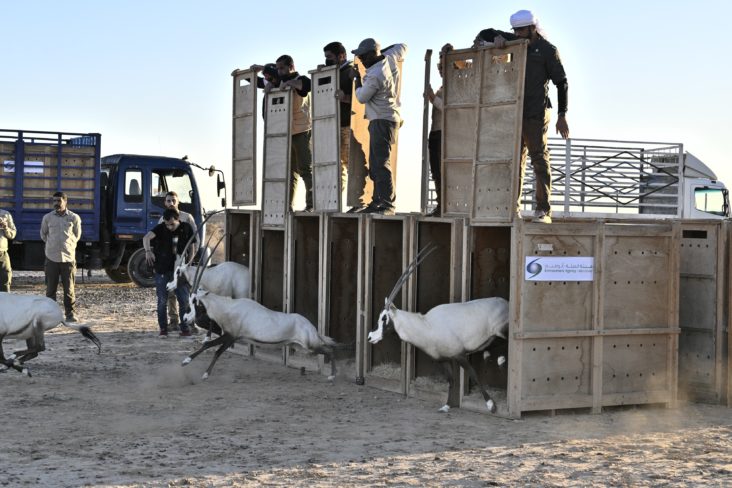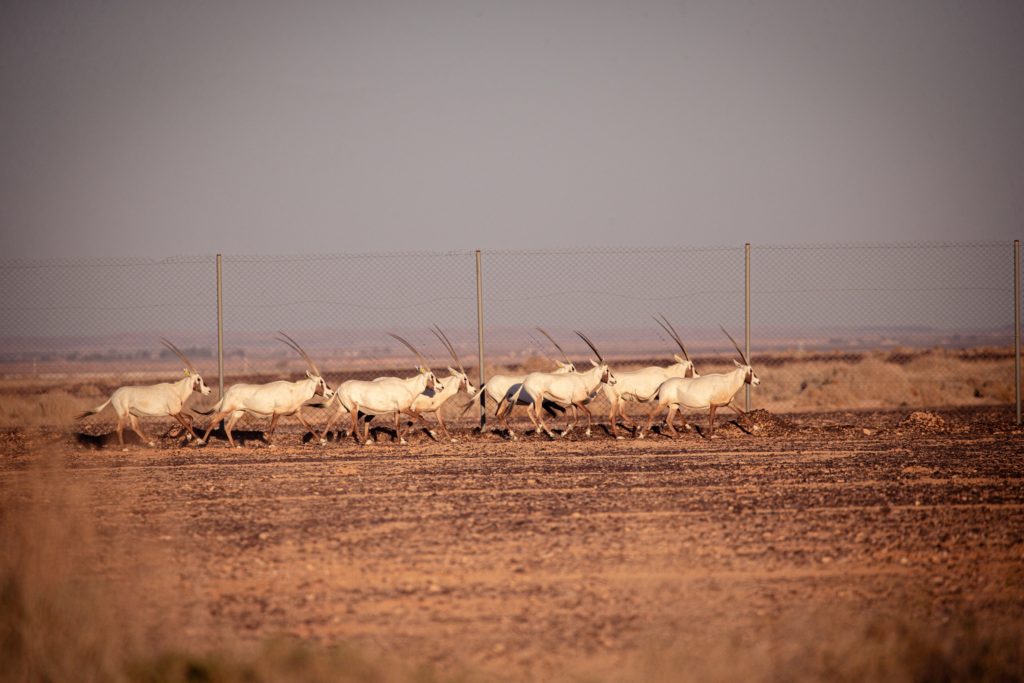20 Arabian Oryx Released In Shumari Wildlife Reserve In Jordan

The Environment Agency – Abu Dhabi (EAD) recently completed a successful project in Jordan, transferring 20 Arabian Oryx to the Shumari Wildlife Reserve.
The project is part of the Sheikh Mohamed bin Zayed Arabian Oryx Reintroduction Programme, which is regarded as one of the world’s most successful conservation programmes.
The release of the Arabian Oryx is an important step toward the reintroduction of the animal and increasing its numbers in nature and world wildlife reserves, where it once lived. It also facilitates the formation of growing herds capable of self-sufficiency and roaming freely in their natural habitats under effective management and a long-term protection plan.
The Arabian Oryx release is part of a memorandum of understanding, signed between EAD and the Royal Society for the Conservation of Nature (RSCN), on a project to develop a vital herd of Arabian Oryx in the Shumari Wildlife Reserve in Jordan.The two organisations will collaborate to establish a vital and sustainable herd of Arabian Oryx in the reserve by diversifying genetic resources and rehabilitation.
The project, which is managed by EAD and implemented by RSCN, aimed to release 20 Arabian Oryx in the Shumari Wildlife Reserve, whilst ensuring their adaptation to the region’s environment. Furthermore, the project strives to improve the genetic structure of the existing herd and reduce the possibility of genetic imbalances to create a lively herd and sustain suitable and sufficient pastoral areas for Arabian Oryx individuals.
The Shumari Wildlife Reserve will be expanded by rehabilitating land outside the reserve’s boundaries to ensure that there are enough suitable new grazing sites for the Arabian Oryx. The project also intends to create a programme and an educational centre for school students to raise environmental awareness toward breeding and resettlement programmes, implement an eco-tourism programme to benefit from the Arabian Oryx breeding programme, and raise awareness among reserve visitors.
The Arabian Oryx release group was chosen to include a homogeneous and genetically diverse herd from the life department and facility at the EAD breeding group.The reserve’s adaptation pens will continue to be veterinary monitored and the Oryx will be monitored post-release to ensure that they are in good condition, healthy, and capable of adapting well to their new surroundings.
Ahmed Al Hashmi, Executive Director of the Terrestrial and Marine Biodiversity Division at EAD said: “The release of the Arabian Oryx in Jordan is a continuation of the efforts initiated by the late Sheikh Zayed bin Sultan Al Nahyan, the Founding Father of the United Arab Emirates who was dedicated to preserving the cultural and natural heritage in the Arabian Peninsula. It is also part of the implementation of the programme of His Highness Sheikh Mohammed bin Zayed Al Nahyan, Crown Prince of Abu Dhabi and Deputy Supreme Commander of the UAE Armed Forces, to resettle the Arabian Oryx in natural areas of spread, which was launched in 2007 and contributed to enhancing the numbers of Oryx in the wild. This ambitious programme has contributed to strengthening efforts to protect the Arabian Oryx and increase its numbers in the wild, as well as changing the Arabian Oryx’s status in the International Union for Conservation of Nature’s (IUCN) Red List from “threatened” to “vulnerable” in 2011, a move considered one of the most significant achievements in the field of species reintroduction at the global level.
“The programme has undertaken extensive breeding and reintroduction programmes, andso far, more than 1,000 Arabian Oryx have been released across the UAE, Oman and Jordan. Today, the Arabian Oryx Conservation Programme is considered as one of the world’s most successful conservation programmes, which has helped increase the number of Arabian Oryx in the UAE to 10,000, with5,000 currently located in Abu Dhabi, which is considered the largest group of Arabian Oryx in the world.”
EAD hosted the General Secretariat for the Conservation of the Arabian Oryx, confirming the commitment of Abu Dhabi’s government towards supporting initiatives aimed at restoring the Arabian Oryx to its natural habitat.
Within the framework of the Memorandum of Understanding, signed between EAD and RSCN, a project to develop a vital herd of Arabian Oryx within the Shumari Wildlife Reserve in Jordan, seeks to secure a suitable environment for the Arabian Oryx groups in the reserve, protecting them as well as other wild species.This will enable the possibility of the reserve maintaining a vibrant and healthy herd of Arabian Oryx and implementing other future resettlement programmes. The project will also provide an excellent opportunity to raise awareness among local communities and school students through a variety of activities, as well as involving the local community in various stages of resettlement programmes.
The Shumari Wildlife Reserve, located near the town of Azraq in Jordan, is 120 km east of the capital Amman. Established in 1975, with the support of RSCN and the World Wildlife Fund, the Reserve is the first nature reserve in Jordan. The reserve has witnessed the release of the Arabian Oryx and is a prime Arabian Oryx habitat.




